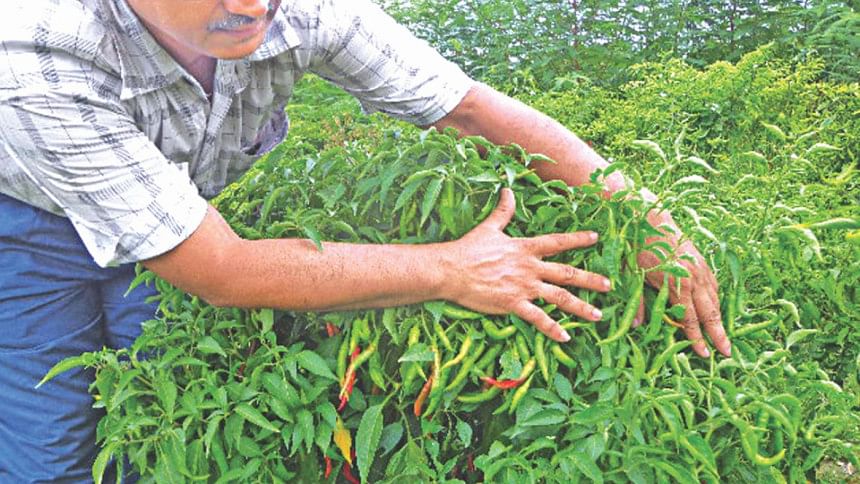Of spices, for spices

Imagine “Chingri Dopeyaja” (shrimp fry with onion) without onion or beef curry without ginger paste or cumin.
Food without spices would be like life without colours to the Bangalee taste bud. However, these spices do not come free.
Every year, the government spends over Tk 1,500 crore to import spices to meet the country's demand for these culinary ingredients.
According to Kalim Uddin, chief scientific officer (CSO) of the Spices Research Centre, Bogra, which conducts research on 35 out of 109 spices used worldwide, Bangladeshis use 27 different spices in their cooking and only 17 of these spices grow in the country. The rest are imported.
Considering the money spent on spice import and exploring opportunities for export, the Spices Research Centre was established in the mid 1990s and it started its research activities in 1998.
The centre works under Bangladesh Agricultural Research Institute (BARI) of Gazipur and it supervises three regional spices research centres in Magura, Comilla and Gazipur's Joydebpur and four sub-regional centres in Lalmonirhat, Faridpur, Khagrachhari and Jaintapur of Sylhet.
Kalim Uddin serves as the in-charge of the centre leading 14 expert scientists, nine scientific assistant and around 30 staff.
Another 80 regular and 70 irregular field labourers work daily on the 70 acres of land of the research centre located beside Bogra-Shibganj road under Shibganj upazila in Bogra.
Scientists at the centre said that so far 31 high-yielding varieties of 14 crop spices were invented along with 84 production technologies, which detailed how the high-yielding varieties should be planted and grown to ensure high standard.
During harvesting time, the centre provides training on the use of fertiliser, pesticide, and harvesting process to the root-level farmers, staff of Department of Agricultural Extension (DAE), Bangladesh Agricultural Development Corporation (BADC) and agri-related officials and employees of different NGOs.
In fiscal 2014-15, trainings were provided to 1,830 farmers, 320 officers of DAE, BADC and NGOs, said Kalim Uddin.
The centre has also preserved 257 varieties of Germplasm -- seed or plant tissue -- for research to improve standard of the spices' varieties.

So far success has been achieved in the research of a number of spices, including garlic, onion, cumin, cardamom, clove, scented grass (Vaduri Pata), lemon grass and curry leaf.
Kalim Uddin said the centre's innovation in Vaduri Pata can produce the scent of Pulao in normal cooked rice, when the crushed leaf is sprinkled over the rice.
The success in onion research has been notable as the centre invented three summer varieties which can meet the demand for onions during off season.
The CSO said each year 13.5 lakh metric tonnes of onions are produced but the country's demand is 22 lakh metric tonnes, met partially through imports from India, Myanmar and some other neighbouring countries.
“Summer-seasonal, high yielding onions -- BARI Onion-2, 3, 5, which can be produced during the Bangla month of Ashwin-Kartik, can be a boon for the economy of the country,” said Kalim Uddin.
“The prices of onion would also go down and become more affordable for people once the high-yielding varieties are cultivated,” he said, adding that they had not yet released the seeds of these varieties to farmers.
These hybrid varieties have almost three times more production capability than local varieties, Kalim Uddin said.
Similar to the high-yielding onions, the research centre came up with BARI Garlic 3 and 4, which is expected to meet the demand of garlic of the country and reduce import expenditure.
“The research centre has been prioritising research in introducing climate changed-based salty and tolerant varieties of spices,” said the CSO.
The centre is also trying to come up with innovation wherein two or more spice crops can be grown alongside simultaneously, he added.
Regarding spice export, sources in the centre said some companies like Pran, BD Foods and Hortex Foundation have recently been exporting different spices, including fresh green chilli and green chilli powder to Asian countries where the demands are high.
The centre has its limitations too which include scarcity of land, lack of quality seeds and disease-free plants, lack of opportunity to collect Germplasm from exotic sources and link with the international spices research organisations and lack of storage facilities at root level.
The CSO also noted the decreasing interest among farmers in cultivating spices instead of vegetables and cereal crops and the impact on spice cultivation due to climate change and humidity increase have posed additional challenge to the research centre.
Kalim Uddin urged that the media and organisations, including DAE and BADC, should encourage farmers to cultivate spices, which in turn would inspire the centre in their research activities.

 For all latest news, follow The Daily Star's Google News channel.
For all latest news, follow The Daily Star's Google News channel. 



Comments